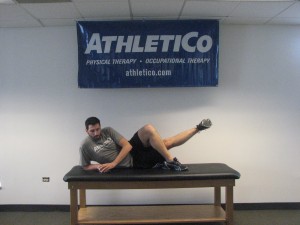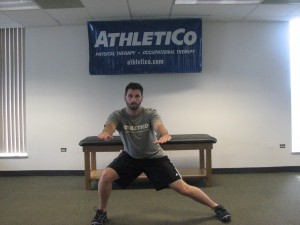When doctors talk about true groin muscles, they’re referring to the group of muscles on the inner part of the leg near the hip also known as the adductor group. The main responsibility of these muscles is to move your leg towards the midline and across the front of your body (adduction). They also play secondary roles in helping to flex the hip (hip flexors) and control hip & leg rotation, making them extremely important muscles for people that run and scramble in unpredictable directions for a living.
Adductor injuries often occur during explosive movements – like sprinting or making a sudden change in direction. This is due to the fact that when we sprint or make a hard cut in sports, we’re recruiting every muscle we can do move as fast as possible. These muscles help with these movements, but it’s not their main job, meaning they are potentially the weakest link in the chain. If this is the case, the excessive demand can cause an injury. The other common cause of a groin injury is from the adductor muscles being overstretched. This typically happens when the leg is unexpectedly moved away from the middle of the body – think of doing the splits, with your legs going out to the side. This usually occurs from a play on an unstable surface or a heroic play where somebody pushes their body to the limit. In Cutler’s case, it appears that his leg moved unexpectedly as he was rolled onto his back by a sprinting 300 pound nose tackle– a legitimate, albeit less common cause.
Treatment for a groin injury can be frustrating due to the amount of time it takes for the body to fully heal. Initially, you’ll want to stick with the standard RICE (rest, ice, compress, elevate) protocol for the first few days to let the inflammation calm down. After that you’ll want to work with a physical therapist and/or athletic trainer to establish an exercise routine that will gradually restore your range of motion and strength. Recovery time varies based on the severity of the injury, so making concrete predictions of a full return are almost impossible. In general, return to play decisions are made based off of symptoms and pain levels, meaning that activities simply need to be tried in gradually increasing intensities to make sure no pain develops. You have to walk before you can run before you can sprint. This is where the guidance of a medical professional is key to ensuring a safe return to play.
Seeing how tedious recovery can be, I’d say that preventing adductor injuries is ideal. Maintaining flexibility and strength is a good way to assist in prevention. Here are a couple of activities to mix into your lower body exercise routine:
Lateral Lunge Stretch
Starting with your feet should width apart, step to one side, bending the knee on the leg in motion and keeping the opposite knee straight. Find a stepping distance that allows you to feel a gentle stretch in the inner part of your thigh. Hold this for 30 seconds and repeat 3-5 times.
Inner Leg Lifts

Lay on your side with your bottom leg straight and your top leg crossed in front of you. Keeping your toes pointed forward, lift your bottom leg towards the ceiling. You’ll only be able to lift it a few inches from the ground.
Working these exercises into your normal routine shouldn’t take more than a few minutes and if you play a higher risk sport – soccer, hockey, or football – it might even save you a few weeks on the sidelines.



1 Comment
Stefano Mann
Interesting
What are your thoughts on poor core stability resulting in groin injuries?
So more chronic/overuse groin injuries like OP etc